Search results for 'ITS 320'
-
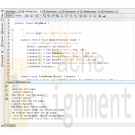
ITS 320 Assignment 5 Inheritance and Polymorphism Java Program
$15.00ITS 320 Assignment 5 Inheritance and Polymorphism Java Program
Key in the PolyMain, Book, Almanac, and Novel classes defined in this module of the course. Once you get each of these classes keyed in, make sure they compile and execute properly. Then create a third subclass called Phone that also extends the Book class. The Phone class should keep track of the number of yellow pages and the number of white pages in each phone book. Make sure the Phone subclass you create has a print method having the same signature as the print method in the Book class. The print method from the Phone class should print the title of the book, followed by the number of yellow pages and white pages contained within the phone book. Thus, the print method should have the following signature:
public void print();The Phone class should also have a constructor having the following signature:
public Phone(String title, int whitePages, int yellowPages);
This constructor should sum up whitePages + yellowPages to get the total number of pages in the book. Remember the total pages in the book and the title of the book are set in the constructor for the Book class.
Modify the PolyMain class to create at least one of your phone books and store it in the library. You should now be able to print the library without having to modify the print method defined within the PolyMain class.
Learn More -
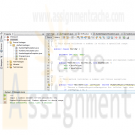
ITS320 Assignment 6 BadDataException Java Program
$15.00ITS320 Assignment 6 BadDataException Java Program
Create three exception classes named NumberHighException, NumberLowException, and NumberNegativeException. Both NumberHighException and NumberLowException should be directly subclassed from the Exception class, but NumberNegativeException should be subclassed from NumberLowException. You can use the BadDataException class that was defined in this module as the model for your exception classes.
Next create a class called Verify that will be used to validate that a number is within a specified range. It should have one constructor that has 2 int parameters. The 1st parameter is the minimum number in the range, and the 2nd parameter is the maximum number in the range.
In addition to the constructor, the Verify class should have one method that is named validate. The validate method will have a single parameter of data type int. The parameter contains the number that is being validated. If the value of the parameter is less than zero, the method should throw a NumberNegativeException. If the value is less than the minimum value of the range, it should throw a NumberLowException. If the value is greater than the maximum value of the range, it should throw a NumberHighException. If the value is within the specified range, no exception should be thrown.
Once all of these classes are created, create the driver class called Program5. The driver class should instantiate a Verify object with a range of 10 to 100. It should then do the following:
Prompt the user to input a number within the specified range.
Use a Scanner to read the user input as an int. You can ensure that an int was entered because the nextInt method in the validate class throws an InputMismatchException if any non digits are entered.
Call the validate method to validate that the number is within the range.
Print an appropriate error message if the value is not within the range, or print the value if it is within the range.BadDataException class
public class BadDataException extends Exception
{
// creates exception object with no message
// null message in superclass
public BadDataException()
{ }// str used for exception message
// explicitly invokes superclass constructor
public BadDataException(String str)
{
super(str);
}public String toString()
Learn More
{
return "BadDataException";
}
} -

Microsoft Access 2010 Chapter 4 Lab 1 Presenting Data in the ECO Clothesline Database
$20.00Microsoft Access 2010 Chapter 4 Lab 1 Presenting Data in the ECO Clothesline Database
Problem: The management of ECO Clothesline already has realized the benefits from the database of customers and sales reps that you created. The management now would like to prepare reports and forms for the database.
Instructions: If you are using the Microsoft Access 2010 Complete or the Microsoft Access 2010 Comprehensive text, open the ECO Clothesline database that you used in Chapter 3. Otherwise, see your instructor for information on accessing the files required in this book.
Perform the following tasks:
1. Open in Layout view the Customer Balance Report you created in Chapter 1 and revised in Chapter 3. Modify the report to create the report shown in Figure 4–81. Group the report by Customer Type and sort by Customer Number within Customer Type. Add the Amount Paid field to the report and include totals for the Balance and Amount Paid fields.2. Create the Customers by Sales Rep report shown in Figure 4–82. Include a total for the Balance field. Change the orientation to landscape. Make sure the total control displays completely. (Hint: Use Layout view to make this adjustment.)
3. Create the Customer Financial Form shown in Figure 4–83. The form includes the date.
4. Create mailing labels for the Customer table. Use Avery labels C2163 and format the labels with customer name on the first line, street on the second line, and city, state, and postal code on the third line. Include a comma and a space after city and a space between state and postal code. Sort the labels by postal code.
5. Submit the revised database in the format specified by your instructor.
Learn More -

ITS 320 Java Program 1 Verify Java and IDE Setup
$12.00ITS 320 Java Program 1 Verify Java and IDE Setup
This simple exercise is meant to verify that you’ve properly installed Java SE and an IDE on your computer so that you are ready for the later programming assignments in this class.
Type in the following program source code from Joyce Farrell’s 4th Edition Java textbook to your IDE. Then modify the comments for your name and the current date, and change the class file name to reflect your first name. Then compile your code.
/**
Program #1
Function: Simple Java application to demonstrate the behavior of
different data types, arithmetic, concatenation, and
output of results.
Programmed By: Reggie Haseltine, instructor (July 18, 2009)
Code Taken From: "Java Programming (Fourth Edition" by Joyce Farrell,
Figure 2-26, page 61
*/public class P1_Reggie {
public static void main(String[] args) {
int oneInt = 315;
short oneShort = 23;
long oneLong = 1234567876543L;
int value1 = 43, value2 = 10, sum, difference, product, quotient, modulus;
boolean isProgrammingFun = true;
double doubNum1 = 2.3, doubNum2 = 14.8, doubResult
char myGrade = 'A', myFriendsGrade = 'C';
System.out.println("Our grades are " + myGrade + " and "
+ myFriendsGrade);
doubResult = doubNum1 + doubNum2;
System.out.println("The sum of the doubles is " + doubResult);
doubResult = doubNum1 * doubNum2;
System.out.println("The product of the doubles is " + doubResult);
System.out.println("The value of isProgrammingFun is "
+ isProgrammingFun);
System.out.println("The value of isProgrammingHard is "
+ isProgrammingFun);
System.out.println("The int is " + oneInt);
System.out.println("The short is " + oneShort);
System.out.println("The long is " + oneLong);
sum = value1 + value2;
difference = value1 - value2;
product = value1 * value2;
quotient = value1 / value2;
modulus = value1 % value2;
System.out.println("Sum is " + sum);
System.out.println("Difference is " + difference);
System.out.println("Product is " + product);
System.out.println("Quotient is " + quotient);
System.out.println("Modulus is " + modulus);
System.out.println("\nThis is on one line\nThis on another");
System.out.println("This shows\thow\ttabs\twork");
}
// end method main
}Then execute the .class file and verify that you get the following output.
Learn More -
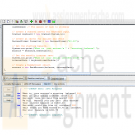
ITS 320 Java Program 2 Custom BankAccount Class with a Modified Constructor
$15.00ITS 320 Java Program 2 Custom BankAccount Class with a Modified Constructor
1) Enter the code for the two classes "BankAccount.java" and "Program2.java" shown below. The Program2 class is a driver for the BankAccount class. Note that this version of the BankAccount class accepts a monthly interest rate in decimal format which must be calculated by the user.
/**
* BankAccount class
* This class simulates a bank account.
*
* (Taken from "Starting Out with Java - Early Objects
* (Third Edition) by Tony Gaddis, 2008 by Pearson Educ.)
*
*/
public class BankAccount
{
private double balance; // Account balance
private double interestRate; // Interest rate
private double interest; // Interest earned/**
* The constructor initializes the balance
* and interestRate fields with the values
* passed to startBalance and intRate. The
* interest field is assigned to 0.0.
*/
public BankAccount(double startBalance,
double intRate)
{
balance = startBalance;
interestRate = intRate;
interest = 0.0;
}/**
* The deposit method adds the parameter
* amount to the balance field.
*/
public void deposit(double amount)
{
balance += amount;
}
/**
* The withdraw method subtracts the
* parameter amount from the balance
* field.
*/
public void withdraw(double amount)
{
balance -= amount;
}/**
* The addInterest method adds the interest
* for the month to the balance field.
*/
public void addInterest()
{
interest = balance * interestRate;
balance += interest;
}/**
* The getBalance method returns the
* value in the balance field.
*/
public double getBalance()
{
return balance;
}/**
* The getInterest method returns the
* value in the interest field.
*/
public double getInterest()
{
return interest;
}
}/**
*
* Colorado State University – ITS-320 – Basic Programming
*
* This program demonstrates the BankAccount class.
*
* (Taken from "Starting Out with Java - Early Objects
* (Third Edition) by Tony Gaddis, 2008 by Pearson Educ.)
*
* Programmed by: Reggie Haseltine, instructor
*
* Date: June 19, 2010
*
*/
import java.util.Scanner; // Needed for the Scanner class
import java.text.DecimalFormat; // Needed for 2 decimal place amounts
public class Program2 {
public static void main(String[] args)
{
BankAccount account; // To reference a BankAccount object
double balance, // The account's starting balance
interestRate, // The annual interest rate
pay, // The user's pay
cashNeeded; // The amount of cash to withdraw
// Create a Scanner object for keyboard input.
Scanner keyboard = new Scanner(System.in);// Create an object for dollars and cents
DecimalFormat formatter = new DecimalFormat ("#0.00");
// Get the starting balance.
System.out.print("What is your account's " + "starting balance? ");
balance = keyboard.nextDouble();// Get the monthly interest rate.
System.out.print("What is your monthly interest rate? ");
interestRate = keyboard.nextDouble();
// Create a BankAccount object.
account = new BankAccount(balance, interestRate);
// Get the amount of pay for the month.
System.out.print("How much were you paid this month? ");
pay = keyboard.nextDouble();
// Deposit the user's pay into the account.
System.out.println("We will deposit your pay " + "into your account.");
account.deposit(pay);
System.out.println("Your current balance is $" + formatter.format( account.getBalance() ));
// Withdraw some cash from the account.
System.out.print("How much would you like " + "to withdraw? ");
cashNeeded = keyboard.nextDouble();
account.withdraw(cashNeeded);
// Add the monthly interest to the account.
account.addInterest();
// Display the interest earned and the balance.
System.out.println("This month you have earned $" + formatter.format( account.getInterest() ) + " in interest.");
System.out.println("Now your balance is $" + formatter.format( account.getBalance() ) );
}
}Compile the two test files (BankAccount.java first and then Program2.java second). Execute Program2 with the following inputs:
starting balance - $500 (don't enter the dollar sign)
monthly interest rate - 0.00125 (this is a 1.5% annual rate)
monthly pay - $1000 (don't enter the dollar sign)
withdrawal amount - $900 (don't enter the dollar sign)
Verify that you earn $0.75 in interest and have an ending balance at the end of the month of $600.75.
Then modify the BankAccount class's constructor method to create a BankAccount object which stores a monthly interest when the user inputs an annual interest rate of the format "nnn.nn" (i.e. 1.5). Note that the BankAccount constructor stored a monthly interest rate for the BankAccount object's instance field originally, but the user had to convert the annual rate to a monthly rate (i.e. 1.5 to 0.00125). Then modify the Program2 driver class to prompt the user for an annual interest rate. Recompile both classes and execute the modified Program2 driver class again, this time with following inputs:
starting balance - $500 (don't enter the dollar sign)
annual interest rate - 1.5
monthly pay - $1000 (don't enter the dollar sign)
withdrawal amount - $900 (don't enter the dollar sign)
Verify that you still earn $0.75 in interest and still have an ending balance at the end of the month of $600.75 as you did with the original code.Submit only the modified source code files, final user inputs, and final output. Do not submit the original source code, inputs, and output.
Be sure that you include the course, the program number, your name, and the date in your program header. Also include this information at the top of your Microsoft Word file. Include additional comments as necessary and maintain consistent indentation for good programming style as shown and discussed in our text.
2) You may use the Windows Command Prompt command line interface or any Java IDE you choose to compile and execute your program.
3) You are to submit the following deliverables to the Dropbox:
a) A single Microsoft Word file containing a screen snapshot of your Java source code for both Program2.java and BankAccount.java (just the beginnings of the source code is OK) as it appears in your IDE (e.g. jGRASP, Net Beans, JDeveloper, etc.) or editor (e.g. a DOS "more" of the .java file's first screen).
b) A listing of your entire modified version of the Java source code for Program2.java and BankAccount.java in the same Microsoft Word file as item a), and following item a).
You can simply copy and paste the text from your IDE into Word. Be sure to maintain proper code alignment by using Courier font for this item. Do not submit the original source code files! c) A screen snapshot showing all of your program’s inputs and output in the same Microsoft Word file, and following item b) above.4) Your instructor may compile and run your program to verify that it compiles and executes properly.
Learn More
5) You will be evaluated on (in order of importance):
a) Inclusion of all deliverables in Step #3 in a single Word file.
b) Correct execution of your program. This includes getting the correct results with the modified class files!
c) Adequate commenting of your code.
d) Good programming style (as shown and discussed in the textbook's examples).
e) Neatness in packaging and labeling of your deliverables.
6) You must put all your screen snapshots and source code to a single Microsoft Word file. -

Microsoft Access 2010 Chapter 4 Lab 2 Presenting Data in the Walburg Energy Alternatives Database
$25.00Microsoft Access 2010 Chapter 4 Lab 2 Presenting Data in the Walburg Energy Alternatives Database
Problem: The management of Walburg Energy Alternatives already has realized the benefits from the database of items and vendors that you created. The management now would like to prepare reports and forms for the database.
Instructions: If you are using the Microsoft Access 2010 Complete or the Microsoft Access 2010 Comprehensive text, open the Walburg Energy Alternatives database that you used in Chapter 3. Otherwise, see your instructor for information on accessing the files required in this book.Perform the following tasks:
1. Open in Layout view the Inventory Status Report that you created in Chapter 1. Add a total for the Inventory Value field. Be sure the total is completely displayed. Display the average cost. If there are fewer than 10 items on hand, the value should appear in a red bold font. Filter the report for all items
where the number on hand is 5 or less. Save the filtered report as Filtered Inventory Status Report.2. Create the Items by Vendor report shown in Figure 4 – 84.
3. Create the form shown in Figure 4 – 85. If there are fewer than 10 items on hand, the value should appear in a red bold font. Save the form as Item Update Form.
4. Filter the Item Update Form for all items where the cost is less than $3.00 and sort the results in descending order by cost. Save the form as Filtered Item Update Form.
5. Submit the revised database in the format specified by your instructor.
Learn More -
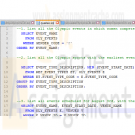
ITSE 2309 Project Database Programming Oracle Olympics Database
$30.00ITSE 2309 Project Database Programming Oracle Olympics Database
Project Objective: Design and implement a database from requirements and execute queries using SQL.
1. Design a database for tracking Olympic events and results.
2. Write scripts to create the database and populate the tables.
3. Write SQL queries to produce reports.Deliverables
1. Create an ER Diagram for your Olympics database.
2. Write a short design document (1 or 2 pages) describing your choices and reasons for designing your database as you did.
3. Provide scripts to create, populate, and teardown the Olympics database.
A. makeOlympicsDb.sql – Script to create tables, constraints, & any DB objects.
B. populateOlympicsDb.sql – Script to add records to the database tables.
C. dropOlympicsDb.sql – Script to delete all tables and database objects.
4. Provide one or more scripts (with .sql file extension) to execute the queries defined for the project. Each script should include comments with your name and query/question number.Database Requirements
The International Olympic Committee is creating a database for their upcoming summer Olympic games. Each sport has competitions for several different events. The competitions for each sport are assigned to a specific venue. A competitor is an individual athlete representing a particular country. Each event is scheduled for a single day and time, and we save a single result for each athlete competing in the event.
Note: For this project, there are no qualifying rounds.
The goal of the database is to identify when and where competitions occur, the athletes competing in events, and the medalists for each competition. Medals are awarded:
1. Gold for 1st place
2. Silver for 2nd place
3. Bronze for 3rd place
For each competition, results are stored for each athlete. The results are recorded as an elapsed time, a score, or a measurement.Data Population
To test the database, you need to populate with data to demonstrate that the database will meet requirements and produce desired reports. For demonstration purposes, the data should be populated with events and competitors for Gymnastics, Track and Field, and Swimming. Use your own creativity to name athletes and choose countries for the competitions. Provide at least 5 competitors for each event. Some athletes should compete in multiple events and some compete in only a single event.Queries
Learn More
1. List all the Olympic events in which women compete, sorted alphabetically. No duplicates.
2. List all the Olympic sports with the earliest event date/time and latest event date/time for the events contested in the sport. Order results by the name of the sport. Each sport should only be listed once.
3. List all events scheduled for August 3rd, with the time and venue of the event. Sort events by the time, with the earliest event listed first. If more than one event starts at the same time, sort by the name of the event.
4. For Gymnastics, list each event and the names of all the athletes competing in those events. Sort results by the name of the event, and secondarily by the name of each athlete.
5. List all the countries in your database and the number of individual athletes from each country. Sort by country name.
6. List all the names of athletes who compete in more than one event along with the name of his/her event and the competition date/time. Sort results by the athlete’s name.
7. List each sport, the names of each event (including gender), and the number of competitors entered into each event.
8. List results for Track and Field’s 100 Meter race with times for each athlete, with fastest time first. List the athlete’s name, country, and race time.
9. List all medal results for events that have already occurred and been entered into the Olympics database. List the sport, event, athlete’s name, country and medal (Gold/Silver/Bronze). Order results by the sport, event, and place. (Gold Medal = 1st Place, Silver = 2nd Place, Bronze = 3rd Place)
10. List the countries that won the most cumulative medals in descending order, listing the number of gold, silver, and bronze medals, along with the total. Report should be sorted with the most medals listed first in the report down to the country with the fewest medals. If countries have the same number of medals, the most Gold/Silver/Bronze next followed by alphabetic listing by country name. -
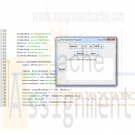
COMP274 Week 6 Programming Assignment The Calendar Program
$25.00COMP274 Week 6 Programming Assignment The Calendar Program
The purpose of this lab is to give you a chance to use some of the data stream tools we have been discussing in a simple application. The assignment is to write a calendar application which allows the user to select a date, and either retrieve a previously stored calendar entry, or save a calendar entry.
Your program should present a GUI interface which allows the user to specify the month, day, and year of the calendar entry. The GUI should also have a text area for displaying and editing a particular entry. It will also need two buttons, one for saving an entry, and the other for retrieving an entry.
Required program elements:
1. Your user interface must allow the user to enter the month, day, and year. You can do this using text fields for input, or you can use ComboBoxes if you feel adventurous.
2. The only GUI components which create events that your program needs to handle are the save and retrieve buttons.
3. Don’t go overboard making your GUI beautiful! We are just looking for basic functionality here!
4. You must have a separate class which manages the calendar data. You will have a minimum of three classes in your application, a user interface class, the calendar manager class, and a calendar test class. The user interface class creates an instance of the calendar manager in its constructor and stores it in a member variable.
5. The calendar manager must provide methods which support saving a specific calendar entry and retrieving a specific calendar entry. The interfaces must be defined to only pass a single day’s calendar entry across the interface.
6. The calendar manager must store calendar data into files according to month+year. That is, the calendar entries for December 2011 must all be stored in the same file.
7. The calendar manager must use ObjectInput/OutputStreams to read/write data from/to files. The calendar manager will use an array to store String objects. The position of a String in this array corresponds to the calendar entry for a specific day.
8. The save method of the calendar manager will need to determine if a file exists for the requested month and year. If so, the object from that file must be read into the calendar manager. Otherwise, the calendar manager must create an empty String array. The new entry must be saved to the appropriate day’s location in the array. The modified array must be saved to the appropriate file.
9. The retrieve method of the calendar manager will need to determine if a file exists for the requested month and year. If not, return an error string indicating that there is no such entry. If the file exists, read the String array from the file and locate the requested day’s entry. If this entry is null, return an error string indicating that there is no such entry, otherwise return the entry.Take screen shots of the output of your program. Paste the screen shots and your source code for your programs into a Word document. Submit your Word document.
Learn More -

ITS407 Module 8 Project Ace Software MySQL Database For Mom and Pop Johnson video store
$25.00ITS407 Module 8 Project Ace Software MySQL Database For Mom and Pop Johnson video store
You are a database consultant with Ace Software, Inc., and have been assigned to develop a database for the Mom and Pop Johnson video store in town. Mom and Pop have been keeping their records of videos and DVDs purchased from distributors and rented to customers in stacks of invoices and piles of rental forms for years. They have finally decided to automate their record keeping with a relational database.
You sit down with Mom and Pop to discuss their business, and watch their operation for about a week. You discover quickly that a video and a DVD are both copies of a movie kept in a separate plastic case that is rented out. They have several copies of each movie they rent, therefore there are several videos and DVDs for each movie title. You learn that in their inventory they have several thousand videos and DVDs, which they get wholesale from about a half dozen distributors. The video and DVD prices to them are based on the quantity of their shipment and the past business they have done with each company.
The price of a DVD for a movie might be different than the price of a video for the same movie, even from the same distributor. Each distributor provides different types of movies (e.g., suspense, horror, mystery, comedy, etc.). A single distributor may provide several different types of movies in both video and DVD format. It is possible to obtain the same movie from multiple distributors and at different wholesale prices.
Each video and DVD has a unique identification number that Mom and Pop assign in their inventory, in addition to the distributor's serial number for the item. Each movie also has a unique identification number Mom and Pop assign in addition to the title and any movie IDs the distributors use in their electronic catalogs. Distributors provide electronic catalogs to Mom and Pop, and the information from these catalogs must be included in the database.
Mom and Pop need to record when a video or DVD is rented, when a video or DVD is returned, and all customer charges such as late and damaged fees, failure to rewind fees, and taxes. They need a report of which videos are returned late because there are standard and late charges. On occasion there are discount prices for certain movies or types of movies. Customers want to rent movies based on actors or actresses, running length, type of movie, rating, year released, the director, and the Academy Awards won (by the movie, the actors, the actresses and/or the directors). Customers also want to know how many videos they have rented in the last month, year, and so forth. Mom and Pop need to keep only basic information on customers in their database, such as name, address, telephone numbers, etc.
There must be no limit to the number of video and/or DVD copies of a movie that Mom and Pop can have in their inventory. Video/DVD ID numbers, movie ID numbers, and distributor ID numbers for videos, DVDs, and movies are all different. Also, each movie must be able to have an unlimited number of actors, actresses, directors, and Academy Awards (i.e., Oscars). Other types of awards (e.g., Golden Globe, People's Choice, etc.) are not of interest for this application. The rental of equipment, sale of videos, DVDs, popcorn, etc., is not to be kept in the database.
1) Identify and describe the entities and their attributes.
2) Develop relationship sentence pairs.
3) Draw an ERD with Visio.
4) Develop metadata from the ERD and document in an Excel spreadsheet.
5) Using your selected RDBMS (SQL Server, Oracle, or MySQL), develop and execute an SQL script file of DDL SQL to create the database tables in the metadata document.
6) Using your selected RDBMS, develop and execute an SQL script file of DML SQL INSERT statements to populate the tables using SQL INSERT statements for at least 5 rows of data per table.
7) Using your selected RDBMS develop and execute an SQL script file to:
a) Show the contents of all tables
b) Retrieve all of the customers' names, account numbers, and addresses (street and zip code only), sorted by account number
c) Retrieve all of the DVDs rented in the last 30 days and sort in chronological rental date order
d) Update a customer name to change their maiden names to married names. You can choose which row to update. Make sure that you use the primary key column in your WHERE clause to affect only a specific row.
e) Delete a specific customer from the database. You can choose which row to delete. Make sure that you use the primary key column in your WHERE clause to affect only a specific row.The metadata should be submitted in an Excel spreadsheet. All other outputs for the database design, SQL code, and SQL results should be submitted in a single Word file in order, by step, and clearly labeled.
Learn More -
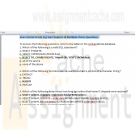
Joan Casteel Oracle 11g SQL Chapters 10 Multiple Choice Questions Solution
$12.00Joan Casteel Oracle 11g SQL Chapters 10 Multiple Choice Questions Solution
To answer the following questions, refer to the tables in the JustLee Books database.
1. Which of the following is a valid SQL statement?
a. SELECT SYSDATE;
b. SELECT UPPER(Hello) FROM dual;
c. SELECT TO_CHAR(SYSDATE, 'Month DD, YYYY') FROM dual;
d. all of the above
e. none of the above2. Which of the following functions can be used to extract a portion of a character string?
a. EXTRACT
b. TRUNC
c. SUBSTR
d. INITCAP3. Which of the following determines how long ago orders that haven’t shipped were received?
a. SELECT order#, shipdate-orderdate delay FROM orders;
b. SELECT order#, SYSDATE – orderdate FROM orders WHERE shipdate IS NULL;
c. SELECT order#, NVL(shipdate, 0) FROM orders WHERE orderdate is NULL;
d. SELECT order#, NULL(shipdate) FROM orders;4. Which of the following SQL statements produces “Hello World” as the output?
a. SELECT "Hello World" FROM dual;
b. SELECT INITCAP('HELLO WORLD') FROM dual;
c. SELECT LOWER('HELLO WORLD') FROM dual;
d. both a and b
e. none of the above5. Which of the following functions can be used to substitute a value for a NULL value?
a. NVL
b. TRUNC
c. NVL2
d. SUBSTR
e. both a and d
f. both a and c6. Which of the following is not a valid format argument for displaying the current time?
a. 'HH:MM:SS'
b. 'HH24:SS'
c. 'HH12:MI:SS'
d. All of the above are valid.7. Which of the following lists only the last four digits of the contact person’s phone number at American Publishing?
a. SELECT EXTRACT(phone, -4, 1) FROM publisher WHERE name ¼ 'AMERICAN PUBLISHING';
b. SELECT SUBSTR(phone, -4, 1) FROM publisher WHERE name = 'AMERICAN PUBLISHING';
c. SELECT EXTRACT(phone, -1, 4) FROM publisher WHERE name = 'AMERICAN PUBLISHING';
d. SELECT SUBSTR(phone, -4, 4) FROM publisher WHERE name = 'AMERICAN PUBLISHING';8. Which of the following functions can be used to determine how many months a book has been available?
a. MONTH
b. MON
c. MONTH_BETWEEN
d. none of the above9. Which of the following displays the order date for order 1000 as 03/31?
a. SELECT TO_CHAR(orderdate, 'MM/DD') FROM orders WHERE order# = 1000;
b. SELECT TO_CHAR(orderdate, 'Mth/DD') FROM orders WHERE order# = 1000;
c. SELECT TO_CHAR(orderdate, 'MONTH/YY') FROM orders WHERE order# = 1000;
d. both a and b
e. none of the above10. Which of the following functions can produce different results, depending on the value of a specified column?
a. NVL
b. DECODE
c. UPPER
d. SUBSTR11. Which of the following SQL statements is not valid?
a. SELECT TO_CHAR(orderdate, '99/9999') FROM orders;
b. SELECT INITCAP(firstname), UPPER(lastname) FROM customers;
c. SELECT cost, retail, TO_CHAR(retail-cost, '$999.99') profit FROM books;
d. all of the above12. Which function can be used to add spaces to a column until it’s a specific width?
a. TRIML
b. PADL
c. LWIDTH
d. none of the above13. Which of the following SELECT statements returns 30 as the result?
a. SELECT ROUND(24.37, 2) FROM dual;
b. SELECT TRUNC(29.99, 2) FROM dual;
c. SELECT ROUND(29.01, -1) FROM dual;
d. SELECT TRUNC(29.99, -1) FROM dual;14. Which of the following is a valid SQL statement?
a. SELECT TRUNC(ROUND(125.38, 1), 0) FROM dual;
b. SELECT ROUND(TRUNC(125.38, 0) FROM dual;
c. SELECT LTRIM(LPAD(state, 5, ' '), 4, -3, "*") FROM dual;
d. SELECT SUBSTR(ROUND(14.87, 2, 1), -4, 1) FROM dual;15. Which of the following functions can’t be used to convert the letter case of a character string?
a. UPPER
b. LOWER
c. INITIALCAP
d. All of the above can be used for case conversion.16. Which of the following format elements causes months to be displayed as a three-letter abbreviation?
a. MMM
b. MONTH
c. MON
d. none of the above17. Which of the following SQL statements displays a customer’s name in all uppercase
characters?
a. SELECT UPPER('firstname', 'lastname') FROM customers;
b. SELECT UPPER(firstname, lastname) FROM customers;
c. SELECT UPPER(lastname, ',' firstname) FROM customers;
d. none of the above18. Which of the following functions can be used to display the character string FLORIDA in the query results whenever FL is entered in the State field?
a. SUBSTR
b. NVL2
c. REPLACE
d. TRUNC
e. none of the above19. What’s the name of the table provided by Oracle 11g for completing queries that don’t involve a table?
a. DUMDUM
b. DUAL
c. ORAC
d. SYS20. If an integer is multiplied by a NULL value, the result is:
Learn More
a. an integer
b. a whole number
c. a NULL value
d. None of the above—a syntax error message is returned.





